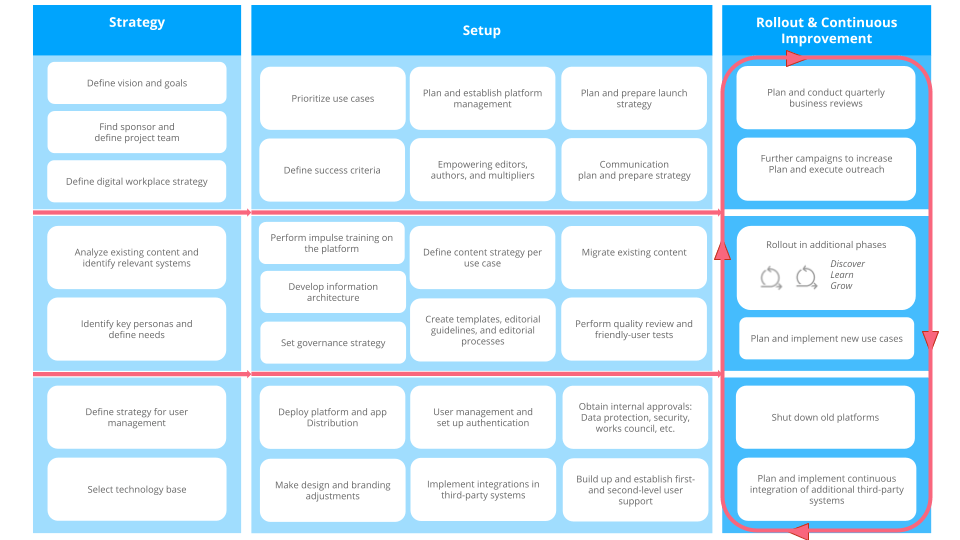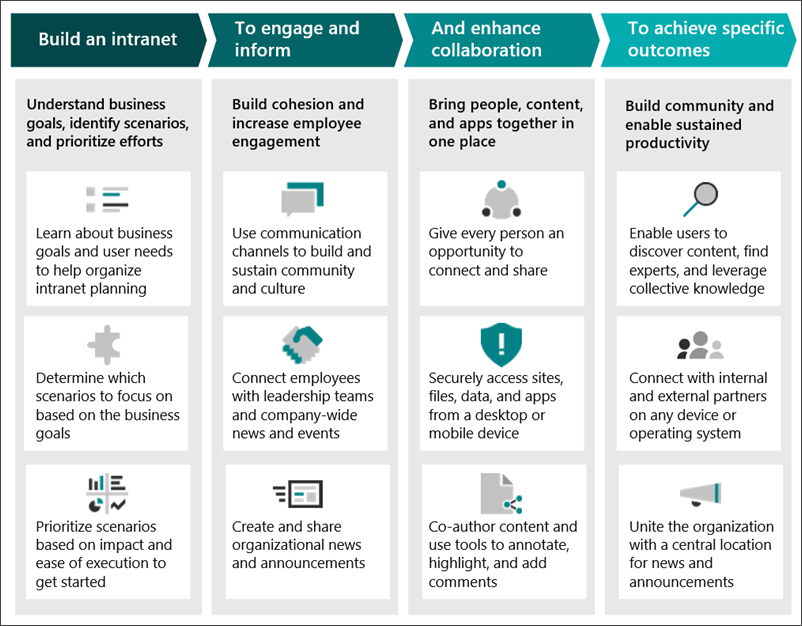Crafting an Intranet Strategy: Vision, Goals, and Objectives
Setting a Vision for Your Intranet
The journey to a transformative intranet begins with a clear vision. It's about envisioning the intranet as the digital pulse of your organization—a platform that doesn't just inform and connect but also engages and inspires every employee.
A vision rooted in your organization's unique culture and aspirations serves as a beacon, guiding the intranet's evolution. It should be both inspiring and grounded, motivating progress while being attainably ambitious.
Before we start...
This is the 2nd article in a series that cover intranet planning, design, development, delivery, and growth. If you missed out on the first article "Maximizing Intranet Usability Through User-Centric Research"... be sure to check it out.
Now, let's talk about goals and objectives!
Defining Measurable Goals and Objectives
Transitioning vision into reality requires setting strategic goals and specific objectives. For instance, aiming to enhance internal communication could involve a targeted 25% boost in employee interaction with internal news over six months.
Utilize the SMART framework to craft objectives that are Specific, Measurable, Achievable, Relevant, and Time-bound, ensuring each step is clear and actionable.

SMART Framework in Action: Enhancing Intranet Engagement
- S - Specific: The goal needs to be clear and direct. For an intranet, a specific goal could be increasing the number of employees actively using the platform for collaboration. A more detailed aim might be, "Increase the usage of collaboration features on the intranet by departmental teams."
- M - Measurable: Establish criteria for measuring progress towards the attainment of the goal. For the intranet, this could involve tracking metrics such as the number of posts, comments, or collaborative projects initiated within the intranet platform. A measurable target might be, "Achieve a 30% increase in collaborative posts and comments by Q2."
- A - Achievable: The goal should be realistic and attainable within the resources, technology, and time available. For our intranet example, ensuring the platform has user-friendly collaboration tools and resources for training and support can make this goal achievable.
- R - Relevant: The goal must align with broader organizational objectives. Enhancing collaboration through the intranet supports overarching goals like improving communication efficiency, fostering innovation, and building a more connected organizational culture.
- T - Time-bound: Setting a deadline provides a sense of urgency and helps in planning and prioritization. For the intranet collaboration goal, a time-bound target could be, "Within six months from the strategy implementation date."
Related: Unlocking Success Through Product Discovery
Applying the SMART Framework: Example Scenario
Goal: "Increase departmental use of the intranet's collaboration features to foster a more engaged and innovative organizational culture."
- Specific: Target the use of specific collaboration features, such as shared workspaces, discussion forums, and project management tools.
- Measurable: Aim for a 30% increase in the usage of these features, measured by active posts, project initiations, and participation in discussion forums.
- Achievable: Provide training sessions and resources on how to use these features effectively. Encourage departments to nominate "intranet champions" to facilitate engagement.
- Relevant: This goal supports the organization's broader objective of enhancing internal communication and fostering a culture of innovation and collaboration.
- Time-bound: Set a target deadline of six months to achieve this increase, with milestones checked monthly.
Aligning Strategy with Organizational Goals
An effective intranet strategy mirrors your organization's broader ambitions. If fostering innovation is a goal, your intranet could feature collaborative spaces for brainstorming and idea cultivation, directly supporting the company's growth.
Mapping intranet features to organizational goals not only aids in prioritization but also strengthens stakeholder engagement.
Case Study: ECZA Intranet and Community Platform
Building a Successful Intranet Strategy Foundation
A robust intranet strategy is built on a clear vision, defined goals, and aligned objectives. These elements steer development, inform decision-making, and serve as success metrics. However, flexibility is key—be ready to adapt as your organization evolves.

Staying Agile and Responsive
Regularly revisit your strategy to ensure it remains relevant. Annual strategy sessions with key stakeholders can be a crucial forum for this reflection. Need help with your intranet strategy and planning? Contact us today.
Stay tuned for more insight into intranet design and development. Subscribe to our newsletter below!
